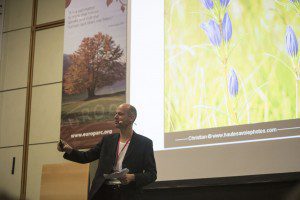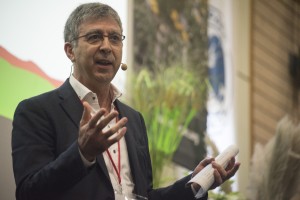Plenary Session at EUROPARC Conference 2016, Parc Jura vaudois, Switzerland © Joao Romba
Below you will find the presentations of each keynote speaker and a short summary of their lectures.

Hans Romang
Swiss Federal Office for the Environment (FOEN), Head of the Species, Ecosystems, Landscapes Division
The creation of parks of national importance in Switzerland (download presentation)
Main outcomes
- Distinct Swiss challenges on a Federal level: landscape shortages in Switzerland
- 2008, new Swiss initative for parks. 15% of the CH surface, 300’000 inhabitants
- 3 instruments in order faciliate park creations : financial support, park label, product label (regional products). Yearly budget of 19.4 Mio
- Parks are catalyts for further funding
- Having an influence on sustainable regional development with the local producers
Outlooks: securing funding, creating valuable bonds, increasing cooperations possibilities, linking actors, making a contribution to the quality of life.
Sébastien Beuchat
Canton de Vaud, Director of ressources and nature heritage
La création des parcs sur le territoire vaudois (download presentation)
Main outcomes
- Main aim: conservation (preservation) of local spaces
- 17th Dec 2008, law of the Cant VD, important for the status of the parks
- Cant VD has 3 parks : Jura Vaudois, Bois Jorat, Pays d’en Haut
- Regional parks are «fine antenne» into the region and have a high credibility due to the proximity to the inhabitants.
- Ecological infrastructures can easily be implemented on a park level. The notion of ecological infrastrutures are good communication vectors for the purpose of parks.
- Challenges with «governance on a regional level»
- It is important to follow the local bonds and cooperations
- Information and sensibilisation are the main purposes for the parks

Olivier Schär
Parc Jura vaudois, Switzerland, Director
La fourmi et le papillon qui voulaient construire une super-colonie (download presentation)
Main outcomes
- Essential qualities in order to create a new community : enhance independance, document, limit, control (monitor)
- Create a new community
- Create a patronage
- Continual evaluations on a local level
- We should give « governance » a new content and wording. It is a the same time real and at the same time a myth. Why should not believe in it.
Karmenu Vella
European Commission, Commissioner for the Environment, Maritime Affairs and Fisheries
Dominique Bourg
University of Lausanne, Institute of geography and durability (IGD)
What rurality, which parks and gouvernance at the future (download presentation)
Main outcomes
- What is the motivation for and the definition of «democracy » in the context of the parks. The aim to increase well-being for all.
- Switzerland places are a high value upon democratic processes as well as the research for dialogue and consensus. (the art of building up a good dialogue)
- Today, certain dogmas (ever increasing GDP) need to be put into question
- General acknowledgement, that the interconnections (relationships) within processes are more complex than originally believed. There is a motivation to go for more authenticity.
- Reflective question : Is the question about governance, emerging now because we are loking for a new orientation ?
- There is a development of a second generation of «governance»
- In order to develop a good basis for governance, information structures and diffusion are essential. Not only is it necessary to diffuse information but also to have enough time to digest and reflect these informations.
Carlos de Oliveira Romao
European Environment Agency, Project Manager
Protected Areas? Isn’t that old fashioned? (download presentation)
- Biodiversity has become a transversal and important issue for parks: parks have a crutial role in the promotion, knowledge management and upkeep of biodiversity strategies and measures.
- National Parc Strategies are essential
- Natura 2000 has positively contributed to the creation and taking care of the protected areas. The Natura 2000 approach has enhanced sustainable regional developments as well.
- The parks, therefore the protected areas, function as networks for all species. At the end this will benefit the cause for biodiversity.
- We already know, that the Strategy 2020 will not be achieved. Mainly, the semi-natural areas will have the most difficulties.
- Farmlands will also be subject to high pressure in the aim for biodiversity.
- In the future more investment is necessary in the protected areas. And more involvement of the local populations to collectively support these actions/initatives.
- Biodiversity outside protected areas is in serious decline. Therefore the involvement of the population is crutial.
- Networks within individual protected areas stand under re-evaluation. New models have to be evolved and procedures have to be evolved.

Inger Andersen
International Union for Conservation of Nature (IUCN), Director-General
Conserving nature, embracing diversity, making it count (download audio)
- Our planet stands at a crossroad: parks have a unique role as lighthouses in the field of sustainable development
- An awakening is taking place : a growing degree of awareness for nature conservation issues is becoming more and more apparent.
- Protected areas, therefore the parks, are becoming the key areas for action
- A clear shift is apparent purely nature protection areas to the role which urban areas
- There is a necessity : How to engage and incorporate larger parts of society in this movement?
- youth groups / youth movements / youth programms
- Parks are not only «lighthouses» or «islands» : they are part of a larger system – ecosystem.
- There are three main issues to be focused upon. A healthy balance needs to be developed! Stories need to be collected and created.
- urban development
- (human) health
- food (production)
- There is a need to enhance the local population to pick up their voices and take ownership of «their» protected areas. This means developping a bondage, pride as well as identity and reponsibility for an area.
- It is crutial to assure that the project success / outcomes are worked up and diffused. These results and stories are the bases of the success stories for this global movement.
- A cross-fertilisation of the levels and content : networks and interfaces need to be worked up and further employed.
- To practice a holistic approach : not just on the level of the parcs but also peripheral area around the core zones. The connects are important to be communicated.
- Set a focus upon the «healthy» communities who have the force and energy to transmit the messages.
- The need to transmit the importance of «long term processes» in order to improve the conditions.


